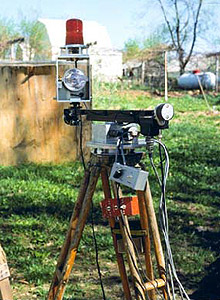Swedish Pole
Purchased from Sweden in the mid-1970s, the National Geodetic Survey used these poles to raise a signal (a light or a mirror) to a height of about 90 feet.

This image shows two Swedish Poles—one Pole with the sections collapsed inside the other sections and the other pole telescoped and guyed.
The National Geodetic Survey (NGS) purchased several "Swedish Poles" from Sweden in the mid-1970s. The Swedish Pole allowed one person to show a light or mirror up to a height of about 90 feet.
Assembling the Swedish Pole
To prepare the pole for use, a truck was backed to a position near the survey mark. Then, the horizontal pole was cranked into a vertical position using a truck rack and winch system designed by an NGS survey party member. Next, using a red ladder, guy wires were attached, and the moveable arm with survey equipment was mounted on the top. The pole was then telescoped upward by cranking a winch at the base of the pole. The guy wires for each section were tightened as that section rose to its fully extended position.

A close-up view of the arm of a Swedish Pole. The black-colored arm rotated around the silver section which was affixed to the top of the pole. The arm also extended in and out. Once centered, the rectangular, silver-colored box with the light rotated around the horizon and the light reflector rotated up and down.
After full height was reached, the guy wires were tightened, and the pole was checked for centering over the survey mark. A survey device known as a "collimator" was set up over the mark, enabling the operator to look straight up. Adjusting the guy wires moved the survey signal almost directly over the survey mark. The survey signal (light and/or mirror) was then moved the last short distance using small electric motors which moved the arm atop the Swedish Pole both around the pole and in-and-out, away from the pole. These electric motors were controlled from the ground.
Once the light and/or mirror were centered directly over the mark, they could be rotated in place until the signal pointed toward the location of the distant observer. In addition, the light had another electric motor which allowed a change in the vertical direction that the light was pointing, and a dimmer which controlled the light intensity. The arm also carried a radio antenna for communication and a tape for measuring the height above the survey mark. All these functions were controlled from the ground. These attachments for the Swedish pole were designed and constructed by NGS employees at the Instrument and Methodology Branch in Corbin, Virginia.
The Swedish Pole was a very versatile piece of equipment, especially since just one person could erect it and show a light and/or mirror up to a height of about 90 feet. The Swedish Pole's main draw-back, if course, was that a surveyor could only survey toward the pole and not away from the pole, since an observer could not stand at the top of the pole and survey.
- Tower shown: Swedish Pole
- Approximate dates of use: Mid-1970s to 1984
- Average heights: Up to 90 feet
- Materials of construction: Steel/metal
- Unique features: Could be erected and used by just one person.
Works Consulted
MacFarland, D. (1978). Construction of Swedish Poles. NGS, unpublished.

 Timber Tower
Timber Tower Dimensional Lumber Tower
Dimensional Lumber Tower Pipe Tower
Pipe Tower Bilby Tower
Bilby Tower Peck Tower
Peck Tower Four-foot Stand
Four-foot Stand Truck Mounted Observing Tower
Truck Mounted Observing Tower G-Tower
G-Tower Trailer Mounted Tower
Trailer Mounted Tower Swedish Pole
Swedish Pole